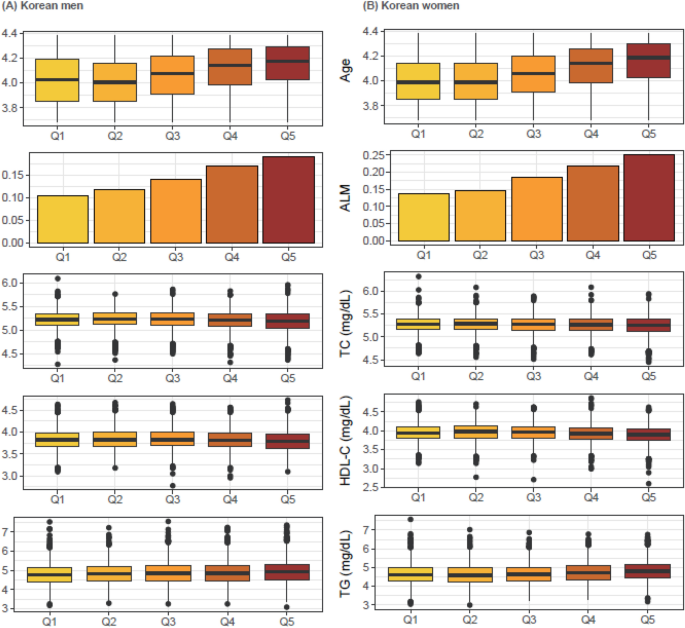
Our study integrated and analyzed Korean-representative cohorts and demonstrated that the UACR correlated positively with TG and TC and negatively with HDL in both men and women. These results are consistent with stratified analysis. Additionally, we observed the association patterns of the UACR and lipid profiles according to sex and found nonlinear relationships between the UACR and lipid profiles in most lipid profiles; however, a monotonically positive correlation was observed between TG and UACR.
The correlation between TG levels and proteinuria was first reported by Tozawa et al.7. They showed that the TG level was a risk factor for the development of proteinuria among 4326 Japanese participants. However, there is limited understanding of the correlation between proteinuria and TG levels as proteinuria was measured using dipstick test. Tien et al. evaluated albuminuria as a categorical variable (normal, moderately elevated, or severe elevated) and TG levels in 2349 Chinese patients with diabetes from two medical centers11. Wang et al. evaluated the correlation between TG levels and UACR in 34,569 Chinese participants from eight centers8. Moreover, the TG-glucose index recently found to be positively associated with albuminuria in patients with hypertension12; however, the UACR measurement units were not unified; therefore, the UACR could not be evaluated as a continuous variable. Conversely, our study analyzed both parameters as continuous variables to provide a more precise analysis.
Protein loss from glomeruli activates several signals through the renal tubules to increase TG production13. TG-rich (Apoprotein B) ApoB-containing lipoproteins promote kidney disease progression14. Additionally, high TG levels are associated with factor VII and plasminogen activator inhibitor levels, which are in turn associated with intravascular fibrin deposits, thrombosis, and renal fibrosis, resulting in increased urinary albumin excretion15,16. Increased TG levels caused by insulin resistance impair glucose metabolism and, trigger oxidative stress and chronic inflammation, which can lead to microvascular permeability and increased glomerular urinary albumin excretion17,18. Impaired HDL-C mediated reverse cholesterol transport promotes glomerulosclerosis and tubulointerstitial damage19. Moreover, higher HDL-C levels were associated with a reduced rate of microalbuminuria in patients with diabetes20. Although the exact mechanism has not yet been identified, we believe that these changes in TG and HDL-C levels affect TC levels, resulting in a positive correlation between UACR and TC levels. Consequently, we observed a strong positive correlation between TG levels and UACR among the lipid profiles.
Therefore, we can consider proteinuria not only as an indicator of kidney dysfunction but also as a marker for dyslipidemia1. Additionally, the moderately elevated albuminuria measurement using urine analysis has the advantage of being less invasive and simpler than dyslipidemia measurements using fasting blood tests. The Honolulu Heart Program, which was followed for 27 years, showed that proteinuria, detected by urine dipstick, could independently predict an increased risk of incident CVD21. Excessive protein reabsorption in the proximal tubules of the kidney promotes an inflammatory response22 and reflects the increased transvascular leakage of various proteins, including lipoproteins23. Inflammation elicits local and systemic endothelial dysfunction and CVD24.
Nonetheless, this study had some limitations. First, since this was a cross-sectional study, we were unable to establish a causal relationship; only associations between variables could be identified. Second, several parameters (such as past history and prescribed medications) were obtained from the questionnaire that may have led to biased results. Third, we analyzed the KNHANES, which is a previously archived public dataset and does not include information on the detailed type of medication for chronic disease. Therefore, we could not consider the use of medications, such as angiotensin-converting enzyme inhibitors, angiotensin receptor blockers, or sodium glucose transport protein 2 inhibitors, which may reduce albuminuria. Moreover, the KNHANES we used does not include information on the type of lipid-lowering medication but does include a categorical variable for whether a subject is taking medication. Fourth, we used a single urine spot sample to assess UACR rather than a 24-h urine collection. Fifth, because the KNHANES only evaluated low density lipoprotein cholesterol (LDL-C) in hypertriglyceridemia group (TG > 200 mg/dL), it is challenging to identify a generalized relationship between UACR and LDL-C. Moreover, we were unable to obtain data on the factors influencing blood lipid levels, such as thyroid function, body shape, and digestive tract diseases. Nevertheless, we investigated the correlation between albuminuria and lipid profiles in a single representative group using nationally normalized data.
In conclusion, we showed that lipid profiles, especially TG levels, were associated with UACR. This correlation between albuminuria and dyslipidemia indicates that simple spot urine measurement is a highly useful predictor of dyslipidemia and renal function.
- The Renal Warrior Project. Join Now
- Source: https://www.nature.com/articles/s41598-024-65037-w
